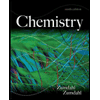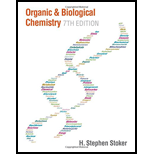
Concept explainers
Classify each of the following hydrocarbons as saturated or unsaturated.
- a. CH3—CH2—CH3
- b. CH3—CH=CH2
- c. CH3—C≡CH
- d. CH3—CH=CH—CH3
(a)
Interpretation:
The given hydrocarbon has to be classified as saturated hydrocarbon or unsaturated hydrocarbon.
Answer to Problem 2.1EP
The given hydrocarbon is a saturated hydrocarbon.
Explanation of Solution
Given structure of hydrocarbon is,
Hydrocarbons are the compounds that contain only carbon and hydrogen atoms in it. Unsaturated hydrocarbons have atleast one double bond or triple bond between the carbon atoms in the molecule. Saturated hydrocarbons contain only single bonds between the carbon atoms.
From the given structure of hydrocarbon, there are no multiple bonds present between the carbon atoms. Hence, the given hydrocarbon is a saturated hydrocarbon.
The given hydrocarbon is a saturated hydrocarbon.
(b)
Interpretation:
The given hydrocarbon has to be classified as saturated hydrocarbon or unsaturated hydrocarbon.
Answer to Problem 2.1EP
The given hydrocarbon is an unsaturated hydrocarbon.
Explanation of Solution
Given structure of hydrocarbon is,
Hydrocarbons are the compounds that contain only carbon and hydrogen atoms in it. Unsaturated hydrocarbons have atleast one double bond or triple bond between the carbon atoms in the molecule. Saturated hydrocarbons contain only single bonds between the carbon atoms.
From the given structure of hydrocarbon, there is one multiple bond (double bond) present between the carbon atoms. Hence, the given hydrocarbon is an unsaturated hydrocarbon.
The given hydrocarbon is an unsaturated hydrocarbon.
(c)
Interpretation:
The given hydrocarbon has to be classified as saturated hydrocarbon or unsaturated hydrocarbon.
Answer to Problem 2.1EP
The given hydrocarbon is an unsaturated hydrocarbon.
Explanation of Solution
Given structure of hydrocarbon is,
Hydrocarbons are the compounds that contain only carbon and hydrogen atoms in it. Unsaturated hydrocarbons have atleast one double bond or triple bond between the carbon atoms in the molecule. Saturated hydrocarbons contain only single bonds between the carbon atoms.
From the given structure of hydrocarbon, there is one multiple bond (triple bond) present between the carbon atoms. Hence, the given hydrocarbon is an unsaturated hydrocarbon.
The given hydrocarbon is an unsaturated hydrocarbon.
(d)
Interpretation:
The given hydrocarbon has to be classified as saturated hydrocarbon or unsaturated hydrocarbon.
Answer to Problem 2.1EP
The given hydrocarbon is an unsaturated hydrocarbon.
Explanation of Solution
Given structure of hydrocarbon is,
Hydrocarbons are the compounds that contain only carbon and hydrogen atoms in it. Unsaturated hydrocarbons have atleast one double bond or triple bond between the carbon atoms in the molecule. Saturated hydrocarbons contain only single bonds between the carbon atoms.
From the given structure of hydrocarbon, there is one multiple bond (double bond) present between the carbon atoms. Hence, the given hydrocarbon is an unsaturated hydrocarbon.
The given hydrocarbon is an unsaturated hydrocarbon.
Want to see more full solutions like this?
Chapter 2 Solutions
Organic And Biological Chemistry
- Alcoholic beverages contain: a. wood alcohol. b. isopropyl alcohol. c. glyceryl alcohol. d. ethyl alcohol.arrow_forwardClassify each of the following hydrocarbons as saturated or unsaturated. a. CH3CH2CH=CH2 b. CH3CH3 c. CH2=CH2 d. CHCCH2CH3arrow_forwardClassify each of the following hydrocarbons as saturated or unsaturated. a. CH3CH2CH3 b. CH3CH=CH2 c. CH3CCH d. CH3CH=CHCH3arrow_forward
- The compound CH2=CHCH2CH2CH3 is an example of: a. a pentane. b. a hexene. c. an alkene. d. organic macromolecule.arrow_forwardWhat is the difference in bonding and in the general molecular formula between an alkene and an alkane with the same number of carbon atoms?arrow_forwardThe general formula of an alkane is CnH2n+2 . What is the general formula of an (a) alkene? (b) alkyne? (c) alcohol derived from an alkane?arrow_forward
 General, Organic, and Biological ChemistryChemistryISBN:9781285853918Author:H. Stephen StokerPublisher:Cengage Learning
General, Organic, and Biological ChemistryChemistryISBN:9781285853918Author:H. Stephen StokerPublisher:Cengage Learning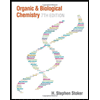 Organic And Biological ChemistryChemistryISBN:9781305081079Author:STOKER, H. Stephen (howard Stephen)Publisher:Cengage Learning,Chemistry: Matter and ChangeChemistryISBN:9780078746376Author:Dinah Zike, Laurel Dingrando, Nicholas Hainen, Cheryl WistromPublisher:Glencoe/McGraw-Hill School Pub Co
Organic And Biological ChemistryChemistryISBN:9781305081079Author:STOKER, H. Stephen (howard Stephen)Publisher:Cengage Learning,Chemistry: Matter and ChangeChemistryISBN:9780078746376Author:Dinah Zike, Laurel Dingrando, Nicholas Hainen, Cheryl WistromPublisher:Glencoe/McGraw-Hill School Pub Co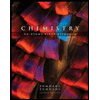 Chemistry: An Atoms First ApproachChemistryISBN:9781305079243Author:Steven S. Zumdahl, Susan A. ZumdahlPublisher:Cengage Learning
Chemistry: An Atoms First ApproachChemistryISBN:9781305079243Author:Steven S. Zumdahl, Susan A. ZumdahlPublisher:Cengage Learning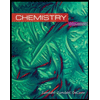 ChemistryChemistryISBN:9781305957404Author:Steven S. Zumdahl, Susan A. Zumdahl, Donald J. DeCostePublisher:Cengage Learning
ChemistryChemistryISBN:9781305957404Author:Steven S. Zumdahl, Susan A. Zumdahl, Donald J. DeCostePublisher:Cengage Learning